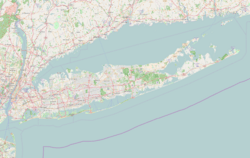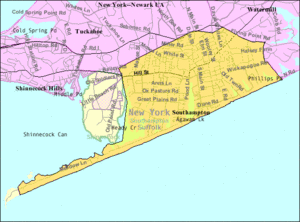Southampton (village), New York facts for kids
Quick facts for kids
Southampton, New York
|
|
|---|---|
| Incorporated Village of Southampton | |

Downtown Southampton in 2014.
|
|
| Etymology: Earl of Southampton | |
| Country | |
| State | |
| County | Suffolk |
| Town | Southampton |
| First Settled | 1640 |
| Incorporation | 1894 |
| Area | |
| • Total | 7.43 sq mi (19.24 km2) |
| • Land | 6.52 sq mi (16.88 km2) |
| • Water | 0.91 sq mi (2.36 km2) |
| Elevation | 26 ft (8 m) |
| Population
(2020)
|
|
| • Total | 4,550 |
| • Density | 698.07/sq mi (269.52/km2) |
| Time zone | UTC-5 (Eastern (EST)) |
| • Summer (DST) | UTC-4 (EDT) |
| ZIP Codes |
11968-11969
|
| Area code(s) | 631, 934 |
| FIPS code | 36-68462 |
| GNIS feature ID | 0965893 |
Southampton is a village in Suffolk County, New York. It's located on the South Fork of Long Island. In 2020, about 4,550 people lived there. This was a big jump in population from ten years earlier.
The Incorporated Village of Southampton is the main town center for the larger Town of Southampton. It's also the oldest and largest community in the famous group of towns known as The Hamptons. Many people visit Southampton during the summer.
Contents
History of Southampton
Southampton was first settled in 1640. It became an official village in 1894. Its story began when a small group of English settlers sailed from Lynn, Massachusetts. They landed on June 12, 1640, at a place now called Conscience Point.
Southampton is the oldest English settlement in New York. It was named after the English Earl of Southampton.
Early Settlers and Native Americans
The Shinnecock tribe welcomed the English settlers in 1640. They gave them land in an area called "Olde Towne." The Shinnecock people also taught the settlers important skills. They shared their knowledge of planting corn using fish as fertilizer. They also showed them how to grow other crops and find clams and scallops in the bays. The Shinnecock also taught them how to trap animals for food.
During the 1700s and 1800s, the main jobs in Southampton were fishing, farming, and raising ducks. Farmers grew a lot of potatoes and local sweet corn.
The early settlers, with help from a Shinnecock guide, found a good spot for their first homes. This spot was at the head of what is now Old Town Pond. The Shinnecock Reservation was set up in 1701. It is one of the oldest Native American reservations in the United States.
The Halsey House is a very old home built in 1660. It belonged to Thomas Halsey, one of the first families to buy land from the Shinnecocks. It is one of the oldest English-style wooden houses in New York State.
Southampton as a Summer Colony
Theodore Gaillard Thomas, a doctor from New York City, helped create Southampton as a resort town. He told his wealthy patients about the beauty of Southampton's countryside. He thought it would be a great place to relax and get healthy. He started working to develop this resort community in 1863.
Dr. Thomas was very successful. Southampton grew into a popular and rich community for summer visitors. He and his friends helped start many important places in Southampton. These include the St. Andrews Dune Church, the Shinnecock Golf Club, and The Parrish Art Museum.
Over time, other villages and towns in the Hamptons also became popular for wealthy summer vacationers. Southampton Village, which was the first to attract rich residents, grew faster than the others. Many famous families have had homes in Southampton, like the Ford, Du Pont, Morgan, and Eisenhower families.
Southampton in the 21st Century
Today, Southampton Village is still known as one of the best summer resort areas in the country. Many important people from American society, politics, and finance spend their summers here.
Because of this, homes in the village are very expensive. The "Estate Section" has most of the homes for very rich residents. This area is just north of the Atlantic Ocean. Streets like Ox Pasture Road and Meadow Lane are especially famous. Meadow Lane is even called "Billionaire Lane" because it has some of the most expensive homes in the country.
Other parts of the village are home to people who live there all year. These neighborhoods are north of Hill Street, extending towards Route 27.
The Shinnecock Indian Reservation is next to the village on its southwest side. The Shinnecock Hills Golf Club, a very old and famous golf course, is on the northwest side. The Art Village, once a summer art school, is now private homes.
Southampton Village has beautiful ocean beaches. Cooper's Beach is one of the most famous. It was even named "America's top beach" in 2010 by Dr. Beach.
Geography of Southampton
Southampton Village covers about 7.43 square miles (19.24 square kilometers). Most of this area is land, about 6.52 square miles (16.88 square kilometers). The rest is water, about 0.91 square miles (2.36 square kilometers).
Population and People
| Historical population | |||
|---|---|---|---|
| Census | Pop. | %± | |
| 1870 | 943 | — | |
| 1880 | 949 | 0.6% | |
| 1900 | 2,289 | — | |
| 1910 | 2,509 | 9.6% | |
| 1920 | 2,891 | 15.2% | |
| 1930 | 3,737 | 29.3% | |
| 1940 | 3,818 | 2.2% | |
| 1950 | 4,042 | 5.9% | |
| 1960 | 4,582 | 13.4% | |
| 1970 | 4,904 | 7.0% | |
| 1980 | 4,000 | −18.4% | |
| 1990 | 3,980 | −0.5% | |
| 2000 | 3,965 | −0.4% | |
| 2010 | 3,109 | −21.6% | |
| 2020 | 4,550 | 46.3% | |
| U.S. Decennial Census | |||
In 2017, about 3,193 people lived in Southampton Village. The population density was about 499 people per square mile.
Most residents were White (74.5%). About 16.7% were Black or African American. About 22.5% of the population was Hispanic or Latino.
The population was spread out by age. About 16.2% were under 19 years old. About 29.9% were 65 years or older. The average age was 55.2 years. The village had slightly more females (54%) than males (46%).
In 2015, the average income for a household in the village was $96,250. For families, the average income was $109,674. Many households (22%) earned over $200,000.
Historic Places
Southampton has several areas that are important for their history and architecture. These are called historic districts:
- Beach Road Historic District
- North Main Street Historic District
- Southampton Village Historic District
- Wickapogue Road Historic District
Famous People from Southampton
Many rich and important people have homes in Southampton's "estate section." This area is right by the Atlantic Ocean. Historically, families like the Ford, Du Pont, Eisenhower, Vanderbilt, and Morgan families lived here. Today, about half of the billionaires who live in the Hamptons have homes in Southampton Village.
Other notable people who have lived in Southampton include:
- Tim Bishop, a former U.S. Representative
- Tory Burch, a fashion designer
- Brooke Shields, an actress
- Ansel Elgort, an actor
- Michael J. Fox, an actor
- Calvin Klein, a fashion designer
- Roy Lichtenstein, a painter
- Steven Mnuchin, a financier and former US Treasury Secretary
- J. P. Morgan, a famous financier
- Chuck Scarborough, a news anchor
- George Soros, a business leader and investor
- Kate Spade, a fashion designer
- Howard Stern, a radio personality
- Tom Wolfe, an author and journalist
Images for kids
See also
 In Spanish: Southampton (villa) para niños
In Spanish: Southampton (villa) para niños












